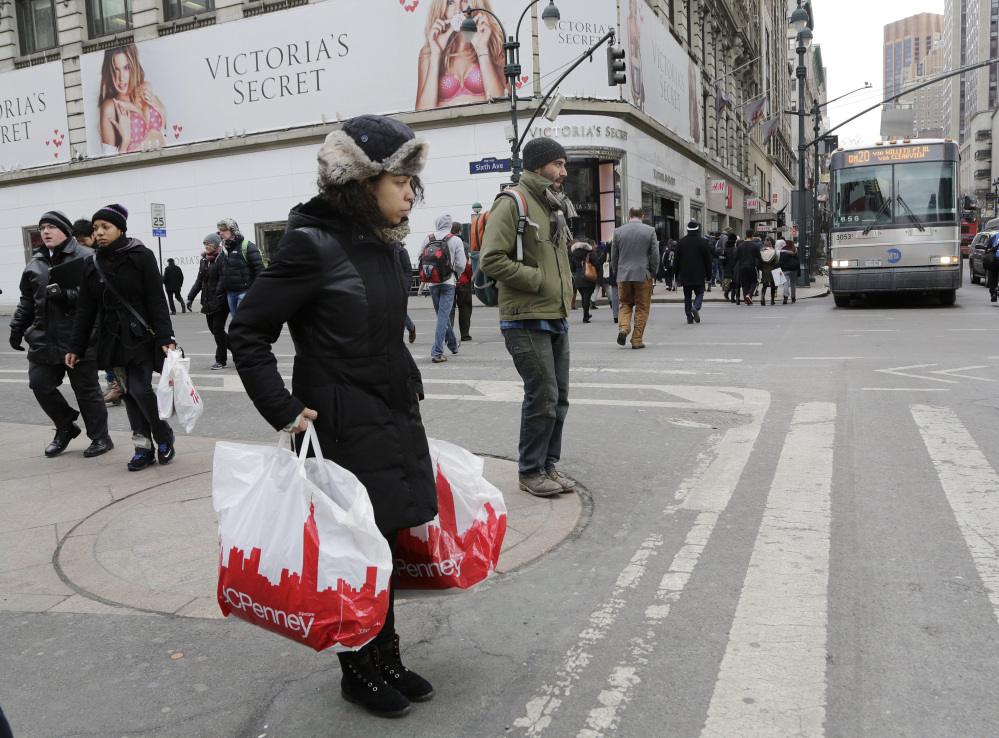WASHINGTON — For a second year, harsh winter weather has kept Americans away from shopping centers, slowed home sales and weighed on U.S. economic growth.
Yet there may be little cause for concern. The steadily strengthening U.S. job market and low gas prices suggest that the slowdown will likely prove temporary – just as a winter-related slump did last year.
Retail sales fell 0.6 percent in February, the government said Thursday, the third straight drop. Americans cut back on car buying by the most in more than a year. Sales also fell at restaurants, home improvement centers and electronics and appliance stores. The figures showed that consumers were slow to boost spending despite robust hiring in the past year and sharply lower gas prices.
A separate report Thursday showed, though, that far fewer people applied for unemployment benefits last week than in the previous week. The report offered evidence that layoffs remain low and that the job market and the economy are still solid.
The retail sales report “doesn’t change our view that the economic recovery is strengthening,” said Paul Ashworth, chief U.S. economist at Capital Economics. “With the labor market on fire, we suspect that incomes, and eventually consumption too, will continue to grow at a healthy pace.”
Details in the spending report supported the notion that Americans are still willing to spend and that sales should rise along with temperatures. Spending in a category that includes online and catalog retailers – which isn’t affected by weather – jumped 2.2 percent last month. It was the biggest gain in nearly a year.
And restaurant sales, which have been accelerating but are particularly weather-sensitive, fell by the largest amount in 13 months.
The report on applications for unemployment aid showed that the number of people seeking first-time benefits plunged 36,000 last week to 289,000. The drop reversed an increase of 40,000 in the previous week. That jump was probably weather-related, given that low temperatures and snowstorms shut construction sites, closed schools and caused a wave of temporary layoffs.
Last week’s decline in applications confirmed that employers are still confident enough in the economy to hold on to their staffs. The number of people applying for unemployment benefits each week tends to reflect the pace of layoffs.
Joseph LaVorgna, an economist at Deutsche Bank, calculates that last month was the coldest since December 2000, measured by the number of days that households used an above-average amount of heat.
With spending weak, a strong dollar holding down U.S. exports, and oil and gas drillers cutting back on investment, economists are marking down their estimates for economic growth in the current January-March quarter.
Jesse Hurwitz, an economist at Barclays Capital, has downgraded his forecast to a tepid annual rate of between 1.5 percent and 1.8 percent. That compares with 2.2 percent annual growth in last year’s fourth quarter and is far below the blistering 4.8 percent pace last spring and summer.
Still, employers added an average of 288,000 jobs a month from December through February, evidence that they regard any slower growth as temporary.
A similar trend occurred last year: The economy shrank in the first three months of 2014, largely because of brutal weather from the “polar vortex.” Even so, employers kept on hiring, and the economy rebounded.
Send questions/comments to the editors.



Success. Please wait for the page to reload. If the page does not reload within 5 seconds, please refresh the page.
Enter your email and password to access comments.
Hi, to comment on stories you must . This profile is in addition to your subscription and website login.
Already have a commenting profile? .
Invalid username/password.
Please check your email to confirm and complete your registration.
Only subscribers are eligible to post comments. Please subscribe or login first for digital access. Here’s why.
Use the form below to reset your password. When you've submitted your account email, we will send an email with a reset code.